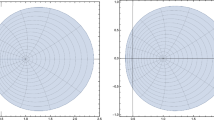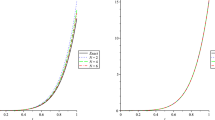Abstract
This paper examines the effect of applying symbolic computation and graphics to enhance students' ability to move from a visual interpretation of mathematical concepts to formal reasoning. The mathematics topics involved, Approximation and Interpolation, were taught according to their historical development, and the students tried to follow the thinking process of the creators of the theory. They used a Computer Algebra System to manipulate algebraic expressions and generate a wide variety of dynamic graphics; thus21st century technology was applied in order to “walk” with the students from the period of Euler in 1748 to the period of Runge in 1901. We describe some situations in which the combination of dynamic graphics,algorithms, and historical perspective enabled the students to improve their understanding of concepts such as limit, convergence, and the quality of approximation.
Similar content being viewed by others
REFERENCES
Arcavi, A., Bruckheimer, M. and Ben-Zvi, R. (1987). History of mathematics for teachers: the case of irrational numbers. For the Learning of Mathematics 7:2.
Arcavi, A. and Bruckheimer, M. (2000). Didactical uses of primary sources from the history of mathematics. Themes in Education 1(1): 55-74.
Artigue, M. (2001). Learning mathematics in a CAS environment: The genesis of a reflection about instrumentation and the dialectics between technical and conceptual work. Paper presented at CAME 2001, Freudenthal Institute, University of Utrecht. http://ltsn.mathstore.ac.uk/came/events/freudenthal/index.html
Breuer, S. and Zwas, G. (1993). Numerical Mathematics - A Laboratory Approach. Cambridge: Cambridge University Press.
Brown, D.P., Porta, H. and Uhl, J. (1991). Calculus & Mathematica. Reading, MA: Addison-Wesley Publishing Company.
Cauchy, A.L. (1821). Cours d' Analyse: Analyse Algebrique. Paris: De Bure.
Chebyshev, P.L. (1856). Sur la Construction des Cartes Geographiques. Oeuvres de P.L. Tchebycheff Publiées par les Soins de mm.A. Markoff et N. Sonin, Vol. 1. New York: Chelsea Publishing Company.
Cornu, B. (1981). Apprentissage de la notion de limite: Modèles spontanés et modèles propres. Proceedings of the 5th International Conference for the Psychology of Mathematics Education (pp. 322-329). Grenoble, France.
Cornu, B. (1991). Limits. In D. Tall (Ed.), Advanced Mathematical Thinking (pp. 153- 166). Dordrecht: Kluwer Academic Publishers.
Cottrill, J. and Dubinsky, E. (1996). Understanding the limit concept: Beginning with a coordinated scheme. The Journal of Mathematical Behavior 15: 167-192.
Courant, R. and Robbins, H. (1941). Revised by Stewart, I. 1996. What is Mathematics? Oxford: Oxford University Press
Davis, P.J. (1975). Interpolation and Approximation. New York: Dover Publications.
Davis, R.B. and Vinner, S. (1986). The notion of limit: Some seemingly unavoidable misconception stages. The Journal of Mathematical Behavior 5: 281-303.
Dreyfus, T. and Hillel, J. (1998). Reconstruction of meanings for function approximation. International Journal of Computers for Mathematical Learning 3: 93-112.
Euler, L. (1748). Introductio in Analysin Infinitorum. Tomus Primus, Lausann?, Apud Marcum-Michaelem Bousquet & Socios.
Euler, L. (1988). Introduction to Analysis of the Infinite, Vol. I (English translation by John Blanton). New York: Springer-Verlag.
Eves, H. (1981). Great Moments in Mathematics, Vol. 2 (after 1650). Washington: MAA.
Kidron, I. (1999). Approximation and Interpolation, Calculus Laboratory, From visual interpretation to formal reasoning. Unpublished Ph.D. Thesis. Hebrew University, Jerusalem, Israel.
Kidron, I. (2001). Teaching Euler's algebraic methods in a Calculus laboratory. Proceedings of the 12th ICMI Conference, Vol. 2 (pp. 368-376). Melbourne, Australia.
Kidron, I. (2002). http://stwww.weizmann.ac.il/g-math/Approximation-examples.html
Kleiner, I. (1991). Rigor and proof in mathematics: A historical perspective. Mathematics Magazine 64: 291-314.
Kline, M. (1972). Mathematical Thought from Ancient to Modern Times, Vol. 2. Oxford: Oxford University Press.
Kolmogorov, A.N. and Yushkevich A.P. (1998). Mathematics of the 19th Century. Birkhaüser Verlag, Basel.
Lagrange, J.L. (1884). Oeuvres. publiées par les soins de M.J.A Serrat, Vol. X, Paris, Gauthier-Villars.
Laugwitz, D. (1994). Real-variable analysis from Cauchy to non-standard analysis. In I. Grattan-Guinness (Ed.), Companion Encyclopedia of the History and Philosophy of the Mathematical Sciences, Vol. 1 (pp. 318-330). Routledge.
Schwarz, H.R. (1989). Numerical Analysis, a Comprehensive Introduction. New York: Wiley.
Stieltjes, T.J. (1882). Oeuvres Complètes, Vol. 1, publiées par les soins de la Société Mathématique d' Amsterdam, Groningen 1914-1918.
Tall, D. (1992). The transition to advanced mathematical thinking: Functions, limits, infinity and proof. In D.A. Grouws (Ed.), Handbook of Research on Mathematics Teaching and Learning (pp. 495-511). New York: Macmillan.
Tall, D. (1993). Real mathematics, rational computers and complex people. Proceedings of the Fifth Annual International Conference on Technology in College Mathematics Teaching (pp. 243-258).
Tall, D. (2000a). Technology and versatile thinking in mathematical development. In Michael O.J. Thomas (Ed.), Proceedings of Time 2000 (pp. 33-50). Auckland, New Zealand.
Tall, D. (2000b). Cognitive development in advanced mathematics using technology. Mathematics Education Research Journal 12(3): 210-230.
Van Maanen, J. (1997). New maths may profit from old methods. For the Learning of Mathematics 17(2): 39-46.
Wolfram, S. (1999). The Mathematica Book,4th edition. New York: Cambridge University Press.
Author information
Authors and Affiliations
Rights and permissions
About this article
Cite this article
Kidron, I. Polynomial Approximation of Functions: Historical Perspective and New Tools. International Journal of Computers for Mathematical Learning 8, 299–331 (2003). https://doi.org/10.1023/B:IJCO.0000021793.71677.cd
Issue Date:
DOI: https://doi.org/10.1023/B:IJCO.0000021793.71677.cd




